
Clinoclase is a hydrous copper arsenate mineral, Cu3AsO4(OH)3. Clinoclase is a rare secondary copper mineral and forms acicular crystals in the fractured weathered zone above copper sulfide deposits. It occurs in vitreous, translucent dark blue to dark greenish blue colored crystals and botryoidal masses. The crystal system is monoclinic 2/m. It has a hardness of 2.5–3 and a relative density of 4.3. Associated minerals include malachite, olivenite, quartz, limonite, adamite, azurite, and brochantite among others.
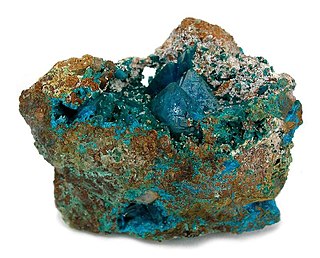
Liroconite is a complex mineral: Hydrated copper aluminium arsenate hydroxide, with the formula Cu2Al[(OH)4|AsO4]·4(H2O). It is a vitreous monoclinic mineral, colored bright blue to green, often associated with malachite, azurite, olivenite, and clinoclase. It is quite soft, with a Mohs hardness of 2–2.5, and has a specific gravity of 2.9–3.0.

Tyrolite is a hydrous calcium copper arsenate carbonate mineral with the formula CaCu5(AsO4)2CO3(OH)4⋅6H2O. Tyrolite forms glassy, blue to green orthorhombic radial crystals and botryoidal masses. It has a Mohs hardness of 1.5–2.0 and a specific gravity of 3.1–3.2. It is translucent with refractive indices of nα = 1.694, nβ = 1.726, and nγ = 1.730.

Vauxite is a phosphate mineral with the chemical formula Fe2+Al2(PO4)2(OH)2·6(H2O). It belongs to the laueite – paravauxite group, paravauxite subgroup, although Mindat puts it as a member of the vantasselite Al4(PO4)3(OH)3·9H2O group. There is no similarity in structure between vauxite and paravauxite Fe2+Al2(PO4)2(OH)2·8H2O or metavauxite Fe3+Al2(PO4)2(OH)2·8H2O, even though they are closely similar chemically and all minerals occur together as secondary minerals. Vauxite was named in 1922 for George Vaux Junior (1863–1927), an American attorney and mineral collector.

Arthurite is a mineral composed of divalent copper and iron ions in combination with trivalent arsenate, phosphate and sulfate ions with hydrogen and oxygen. Initially discovered by Sir Arthur Russell in 1954 at Hingston Down Consols mine in Calstock, Cornwall, England, arthurite is formed as a resultant mineral in the oxidation region of some copper deposits by the variation of enargite or arsenopyrite. The chemical formula of Arthurite is CuFe23+(AsO4,PO4,SO4)2(O,OH)2·4H2O.
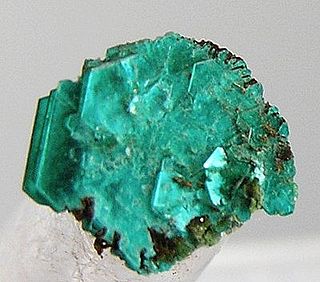
Chalcophyllite is a rare secondary copper arsenate mineral occurring in the oxidized zones of some arsenic-bearing copper deposits. It was first described from material collected in Germany. At one time chalcophyllite from Wheal Tamar in Cornwall, England, was called tamarite, but this name is now discredited. At Wheal Gorland a specimen exhibiting partial replacement of liriconite, Cu
2Al(AsO
4)(OH)
4·(4H
2O), by chalcophyllite has been found. The mineral is named from the Greek, chalco "copper" and fyllon, "leaf", in allusion to its composition and platy structure. It is a classic Cornish mineral that can be confused with tabular spangolite.

Conichalcite, CaCu(AsO4)(OH), is a relatively common arsenate mineral related to duftite (PbCu(AsO4)(OH)). It is green, often botryoidal, and occurs in the oxidation zone of some metal deposits. It occurs with limonite, malachite, beudantite, adamite, cuproadamite, olivenite and smithsonite.

Pseudomalachite is a phosphate of copper with hydroxyl, named from the Greek for "false" and "malachite", because of its similarity in appearance to the carbonate mineral malachite, Cu2(CO3)(OH)2. Both are green coloured secondary minerals found in oxidised zones of copper deposits, often associated with each other. Pseudomalachite is polymorphous with reichenbachite and ludjibaite. It was discovered in 1813. Prior to 1950 it was thought that dihydrite, lunnite, ehlite, tagilite and prasin were separate mineral species, but Berry analysed specimens labelled with these names from several museums, and found that they were in fact pseudomalachite. The old names are no longer recognised by the IMA.

Picropharmacolite, Ca4Mg(AsO3OH)2(AsO4)2·11H2O, is a rare arsenate mineral. It was named in 1819 from the Greek for bitter, in allusion to its magnesium content, and its chemical similarity to pharmacolite. The mineral irhtemite, Ca4Mg(AsO3OH)2(AsO4)2·4H2O, has the same composition as picropharmacolite, except that it has only four water molecules per formula unit, instead of eleven. It may be formed by the dehydration of picropharmacolite.

Lavendulan is an uncommon copper arsenate mineral, known for its characteristic intense electric blue colour. It belongs to the lavendulan group, which has four members:

Tsumebite is a rare phosphate mineral named in 1912 after the locality where it was first found, the Tsumeb mine in Namibia, well known to mineral collectors for the wide range of minerals found there. Tsumebite is a compound phosphate and sulfate of lead and copper, with hydroxyl, formula Pb2Cu(PO4)(SO4)(OH). There is a similar mineral called arsentsumebite, where the phosphate group PO4 is replaced by the arsenate group AsO4, giving the formula Pb2Cu(AsO4)(SO4)(OH). Both minerals are members of the brackebuschite group.
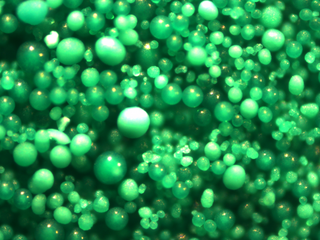
Dicopper chloride trihydroxide is the chemical compound with the formula Cu2(OH)3Cl. It is often referred to as tribasic copper chloride (TBCC), copper trihydroxyl chloride or copper hydroxychloride. It is a greenish crystalline solid encountered in mineral deposits, metal corrosion products, industrial products, art and archeological objects, and some living systems. It was originally manufactured on an industrial scale as a precipitated material used as either a chemical intermediate or a fungicide. Since 1994, a purified, crystallized product has been produced at the scale of thousands of tons per year, and used extensively as a nutritional supplement for animals.
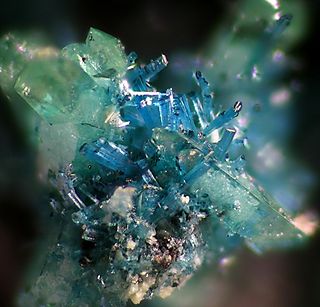
Keyite is a mineral with the chemical formula Cu2+3Zn4Cd2(AsO4)6 · 2H2O. The name comes from Charles Locke Key, an American mineral dealer who furnished its first specimens. Keyite is monoclinic-prismatic, meaning its crystal form has three unequal axes, two of which have 90° angles between them and one with an angle less than 90°. Keyite belongs to the biaxial optical class, meaning it has more than one axis of anisotropy, in which light travels with zero birefringence, and three indices of refraction, nα = 1.800, nβ, and nγ = 1.870. Being a very rare cadmium copper arsenate, keyite is only found in Tsumeb, Namibia in the Tsumeb mine, a world-famous copper mine known for its abundance of rare and unusual minerals.
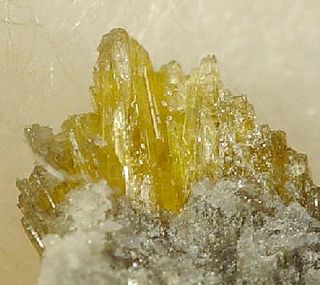
Warikahnite is a rare zinc arsenate mineral of the triclinic crystal system with Hermann-Mauguin notation 1, belonging to the space group P1. It occurs in the Tsumeb mine in Namibia on corroded tennantite in the second oxidation zone under hydrothermal conditions in a dolomite-hosted polymetallic ore deposit. It is associated with adamite, stranskiite, koritnigite, claudetite, tsumcorite, and ludlockite. The origin of discovery was in a dolomite ore formation within an oxidized hydrothermal zone, in the E9 pillar, 31st level of the Tsumeb Mine in Namibia, Southwest Africa. It has also been found at Lavrion, Greece and Plaka, Greece as microscopic white needles.

Strashimirite is a rare monoclinic mineral containing arsenic, copper, hydrogen, and oxygen. It has the chemical formula Cu8(AsO4)4(OH)4·5(H2O).

Cornwallite is an uncommon copper arsenate mineral with formula Cu5(AsO4)2(OH)4. It forms a series with the phosphate pseudomalachite and is a dimorph of the triclinic cornubite. It is a green monoclinic mineral which forms as radial to fibrous encrustations.
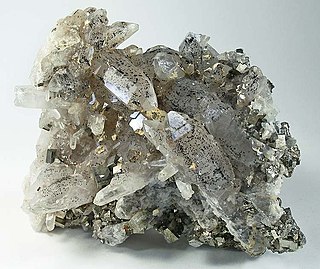
The mineral hubeite, Ca
2Mn2+
Fe3+
[Si
4O
12(OH)]·(H
2O)
2, is a sorosilicate of the Si
4O
13 group. Structurally it also belongs to the Akatoreite group. It was found and named after the province of Hubei, China. It is common to iron ores in a mine of that region. It occurs mainly as aggregates of fan like crystals. It is dark to pale brown, has orange-brown streak and is vitreous. Hubeite has a hardness of 5.5 in the Mohs scale, one good cleavage and conchoidal fracture. It is triclinic with a space group of P1*. The structure of hubeite is very uncommon, and in fact there is only one other mineral that fits the Si
4O
13 group, which is ruizite.

Köttigite is a rare hydrated zinc arsenate which was discovered in 1849 and named by James Dwight Dana in 1850 in honour of Otto Friedrich Köttig (1824–1892), a German chemist from Schneeberg, Saxony, who made the first chemical analysis of the mineral. It has the formula Zn3(AsO4)2·8H2O and it is a dimorph of metaköttigite, which means that the two minerals have the same formula, but a different structure: köttigite is monoclinic and metaköttigite is triclinic. There are several minerals with similar formulae but with other cations in place of the zinc. Iron forms parasymplesite Fe2+3(AsO4)2·8H2O; cobalt forms the distinctively coloured pinkish purple mineral erythrite Co3(AsO4)2·8H2O and nickel forms annabergite Ni3(AsO4)2·8H2O. Köttigite forms series with all three of these minerals and they are all members of the vivianite group.

Carminite (PbFe3+2(AsO4)2(OH)2) is an anhydrous arsenate mineral containing hydroxyl. It is a rare secondary mineral that is structurally related to palermoite (Li2SrAl4(PO4)4(OH)4). Sewardite (CaFe3+2(AsO4)2(OH)2) is an analogue of carminite, with calcium in sewardite in place of the lead in carminite. Mawbyite is a dimorph (same formula, different structure) of carminite; mawbyite is monoclinic and carminite is orthorhombic. It has a molar mass of 639.87 g. It was discovered in 1850 and named for the characteristic carmine colour.
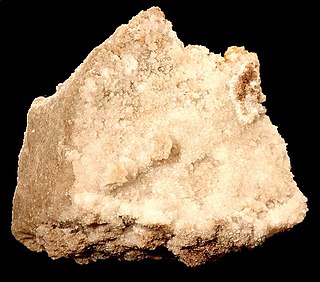
Talmessite is a hydrated calcium magnesium arsenate, often with significant amounts of cobalt or nickel. It was named in 1960 for the type locality, the Talmessi mine, Anarak district, Iran. It forms a series with β-Roselite, where cobalt replaces some of the magnesium, and with gaitite, where zinc replaces the magnesium. All these minerals are members of the fairfieldite group. Talmessite is dimorphic with wendwilsonite.




















